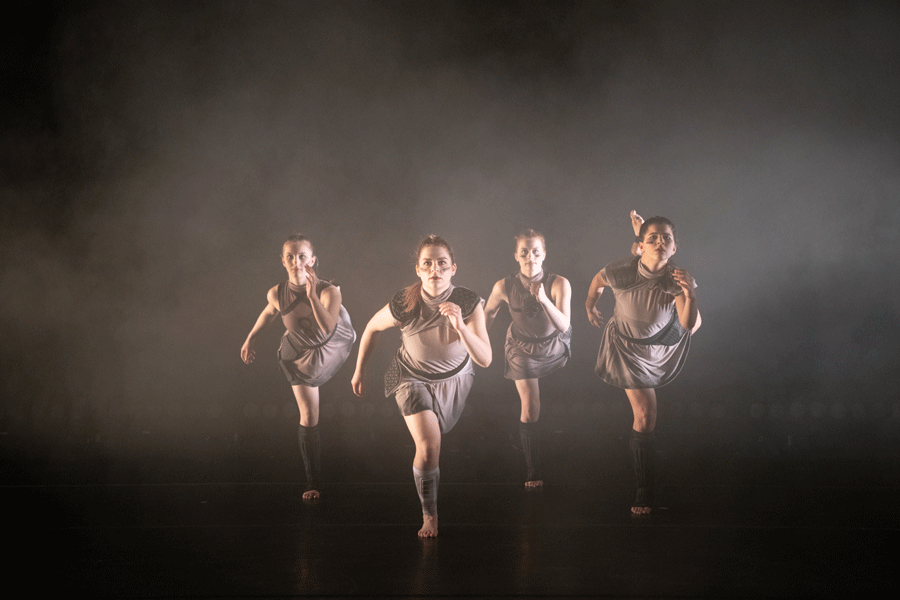2020 edition of Danceworks spotlights the things that matter
Evan Robinson-Johnson/Daily Senior Staffer
Dancers rehearse in “Danceworks.” The show opens March 4.
March 4, 2020
A&E
When Communication Prof. Joel Valentín-Martínez was selecting a theme for “Danceworks 2020,” he wanted something that would be inspiring for the choreographers, but would also let them create the art that interests them. Ultimately, Valentín-Martínez settled on “Things That Matter,” inviting his artistic collaborators to create something that explores the things that matter to them.
“With choreographers, we all have different ways of approaching dance,” he said. “I don’t want to overpush our choreographers to do specific things. I want them to feel free, and I give them an opportunity to fill in the gaps in our canvas.”
Danceworks is an annual dance showcase at Northwestern that features original work by both faculty and guest choreographers. This year’s edition opens Wednesday in the Josephine Louis Theater and will run through Sunday. This is Valentín-Martínez’s fourth year in a row as artistic director of “Danceworks.”
For some of the choreographers, exploring the things that matter means exploring social issues. One of the guest choreographers in the production is Miguel Angel Gamero Ortega, the choreographer of Mexico City’s dance company Barro Rojo Arte Escénico.
In his piece, Ortega decided to focus on the struggles of women. In the dance, the choreographer uses imagery of a sports field and the movement of his female dancers to highlight how women are stereotyped and denied the freedom that men are granted. Ortega said this reflects an ongoing and developing discussion within Mexico about gender roles and how people treat one another, and was inspired by several women in his family.
Most of the choreographers of “Danceworks” rehearse with their dancers twice a week for most of the winter. However, because of scheduling and traveling issues, Ortega rehearsed his piece with his students every single night during a two week period early in the quarter. He said although his dancers had a limited time to work with him, they showed great enthusiasm, and proved adept at exploring the themes Ortega was working with.
“They were not only intellectually engaged, but also physically engaged, and really took on the work,” Ortega said. “I was very proud of them.”
Other choreographers used the theme of things that matter to explore broader ideas. Communication Prof. Jeffery Hancock looked at the passage of time in his piece “Torque.” The entire dance is structured around a spinning plate, where one 360-degree spin of a plate represents a unit of time, and the dancers perform both choreographed and improvised movements based on the movement of this plate.
Hancock said it was a unique experience to create the piece at Northwestern, where students are chronically overscheduled and struggled to make time for rehearsals. Over the course of the process, Hancock only had two rehearsals where everyone was able to be in the space, and his students’ struggles with time made their way into the piece. Hancock said he wanted to use this piece to explore how time changes relationships, and especially how it affects people’s empathy with one another, something he says he has noticed in his own life.
“The way I experience people in space walking down sidewalks and down the street is different than it was five years ago, and certainly different than it was ten years ago,” Hancock said. “I find a lack of empathy in people’s bodies that to me reads as a negation of the agreement that we are living and all civilized and we will work together, and I find that really disturbing. And I think it has to do with a sense of ‘I got to get mine in the time that I have.’”
For Valentín-Martínez himself, what matters is how the music we love can be used as a refuge from hate. For the show, he choreographed a piece called “Pop Refuge,” which tells a narrative of a young woman experiencing internalized homophobia who finds comfort through popular music. Valentín-Martínez includes music from the 80s, when he was a teenager, in the narrative such as Grace Jones and Boy George, as well as a modern pop song from Lizzo.
Valentín-Martínez said as artistic director, his responsibility is to choose the order of the disparate pieces, as well as just provide general oversight to ensure that the show goes smoothly. He said, although this job is a bit stressful, he is proud of the work his students have done to make the show possible.
“When you come into the theater, you simply sit there, you hear a bit of music and the lights begin to dim,” Valentín-Martínez said. “But it took hours of practice by all our student crews, designers and dancers to make this concert as seamless as possible.”
Email: [email protected]
Twitter: @wilsonchapman6


